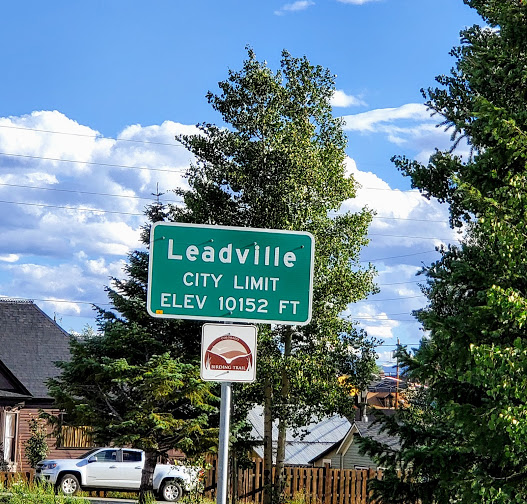
Well, let’s get it started, shall we?
Before the Race:
The Leadville 100 trail run started on Saturday August 17 at 4:00 am. I was pretty concerned I wouldn’t sleep at all the night before, but I somehow managed to sleep a little. I did take a couple melatonin gummies around 8:00pm, so I’m guessing that helped take a little edge off. I slept pretty soundly until 11 when I was awake for a little, but then did fall back asleep.
My alarm went off around 3:00 am and the rest of my team (Wes, Patrick, and Ryan) and crew were already up. I did have coffee before heading out the door. You might think that sounds nuts given that it a.) was 3am, and b.) coffee can have a laxative effect. I chose to go with some coffee because I am a full blown addict. So, my concern was the lack of caffeine giving me a headache later on. Also, coffee rules.
Along with some coffee, I had a bagel and cream cheese. That’s it. No need to stuff myself, but did want some food to help get me started.
Once we were done with food, it was time to head to the starting line. Luckily this race is much smaller therefore much easier to get to and line up. Some races in the past, I’ve had to be there at least an hour beforehand just because the cluster of people is insane. They are classic cases of “hurry up and wait.” In this case, we rolled up around 3:30-45 and were good to go.
Start to May Queen-13.5 miles
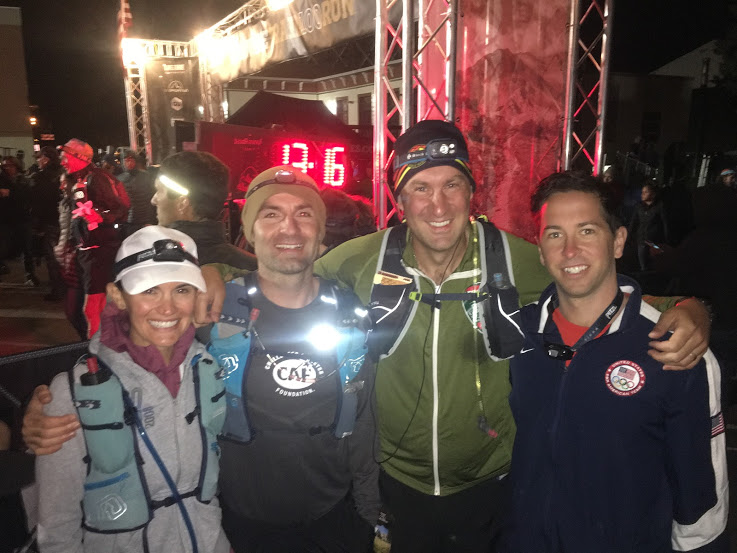
Shotgun went off at 4am. I had my pack with some food and drink, a light jacket on, and my headlamp. No poles yet. I started off running, but tried to keep a modest pace of around 10:30 min/mile. I’ve heard and read a lot of people encourage athletes to run at this point in the race, but not too fast. Runners can sometimes make the mistake of running too fast here because the terrain is relatively easy.
When I say easy, I mean you start out on a paved road, then dirt road, then end up on a relatively flat trail around Turquoise Lake. You run from the starting line up a slight hill, then turn and continue on a flat-ish road for a bit. You will encounter a few steep hills, but not too many. Those hills will give you a couple opportunities to stop and hike up. Lucky you.
The thing I did not realize (although I was told, so turns out I need to be a better listener), is once you start around Turquoise Lake, it’s a single track trail. Not only is it single track, but keep in mind it’s the beginning of the race so everyone is running together. It’s also still dark so you’re managing other runners, the dark, and roots and rocks. That trail gets incredibly backed up with runners and bottle necks. There was one point where we all had to stop, in a single file line, to step over a tree that had fallen.
I was hoping to keep a pace of 10:30, but I had to go to the bathroom along that single track trail. Once I did that, I was stuck back in an 11:30 min/mile pace. I did pass some people when I felt I could do so safely, but I never made that time up.
So, my piece of advice would be if you really want to stick to a certain pace at this point in the race, find that pace before the lake, and wait to use the potty at May Queen.
Falling a minute behind obviously didn’t ruin the race for me, so I tried not to worry about it too much. But it was a point of frustration for a bit. I was hoping to get into May Queen in 2 hours and 10 minutes (10:23 pace), but rolled in at 2:28 (11:48 pace).
May Queen to Outward Bound-10.9 miles
And now the hills begin. By this point, I felt pretty good. I took my jacket off (a super light, easily compact-able Patagonia jacket) and stuffed it in my pack. I lost the rest of my team too at this point so I was ridin’ solo.
One thing that helped me quite a bit during this portion of the race was chatting with other runners. I’m sure we all have our preferences on talking during races, but this race is so damn long how can you not talk to someone?
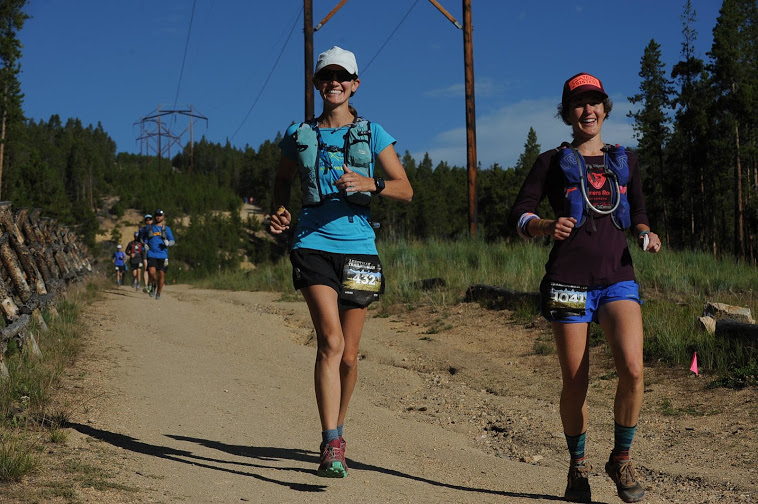
After May Queen, we started a climb on a dirt road. I would jog in spots that were flat, then hike up the steeper climbs. I found a couple of people who seemed to be in the same boat as me and they honestly helped alleviate the pain of the climbs. Once you’re out of May Queen, it’s a 5 mile journey (and 1200 foot climb) to the top of Sugarloaf Pass.
This is where we hit a part of the course called Powerline. Leadville is known for the grueling Hope Pass, but Powerline comes in at a close second. Powerline is tough on runners because it presents numerous false summits. At this point in the race though, when I was still fresh, it wasn’t too bad. It did bite me in the ass though come 3 in the morning. More on that later.
What I will say though is, I believe I came down the other side of Powerline (on the way to Outward Bound), too fast. My knees and quads were destroyed later on and I think blasting downhill during this part of the race may have been the culprit (although maybe it’s just running 50ish miles? Hard to say).
Eventually, we came out of the mountains and started running on road. I could see the Outward Bound aid station and was excited to see my crew and stop for a minute.
Outward Bound is 23.5 miles into the race. It took me 4 hours and 58 minutes. My initial goal was to get there at 4:26.
Best piece of advice for this segment would be to chat with some people, it makes the time/distance go faster. Another would be to watch your pace when coming downhill. You might pay for it later.
Outward Bound to Half Pipe-5.8 miles
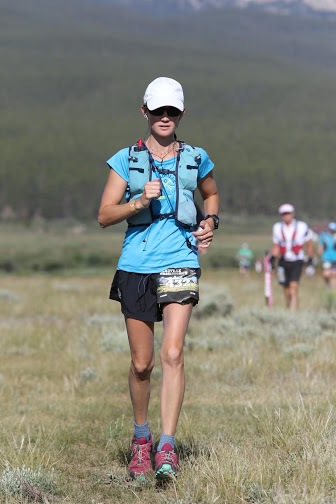
This segment starts out cutting through some grass, then onto paved road. It was getting warm by now and running on the road got old fast. I could feel the heat bouncing off the asphalt. Not my favorite. It was a straight shot too, so it felt like we were there forever.
The road ended eventually, and we turned onto a dirt road to head back into the mountains. I was starting to feel a blister forming on one of my right toes, so I actually stopped in the dirt, took off both shoes and socks, and rubbed my toes with Vaseline. Turns out I did have a blister that had already formed on the one toe, but I was hoping the Vaseline would save the others.
Once my feet were lubed up, I felt really good. I had energy and wanted to use it. The next few miles were a mix of gradual hills and flats mostly under the shade of trees. I took this as an opportunity to jog when I could. The ground was also decent in these parts. Not too hard.

The Half Pipe aid station is smaller than the others and no crew is allowed. I was so excited to see my family at Twin Lakes (the next aid station), so I got in and got out of Half Pipe as quick as I could.
My goal was to get into Half Pipe at 5:53 and I got there in 6:15.
My biggest piece of advice for this section would be to jog/run where you can. The weather was nice, scenery was beautiful, and the ground was forgiving. It’s a good spot to get in some running.
Half Pipe to Twin Lakes-8.6 miles
To me, this section was sort of similar to the previous. The sun was peaking through more though. My body was still feeling good enough that I could jog in spots that were relatively flat, and I’d stop and climb the steeper spots. There were not too many overly demanding climbs here. I just wanted to get to Twin Lakes. I was ready.
Right before the Twin Lakes aid station there’s a downhill portion of the course. By this point, I was feeling a little pain in my knees but nothing debilitating. Finally, I could see the aid station.
My biggest advice: Run in spots that are runable. I think I started to take it easy and therefore I lost a little time. Looking back, I could have pushed harder.
I got to Twin Lakes at 8 hours and 28 minutes and wanted to get there at 7:30.
Twin Lakes to Hope Pass-5.6 miles
Let’s talk about the Twin Lakes aid station. That place is like a town! It was such a relief when I started to see tents and hear people. I was finally going to see my husband and kids!
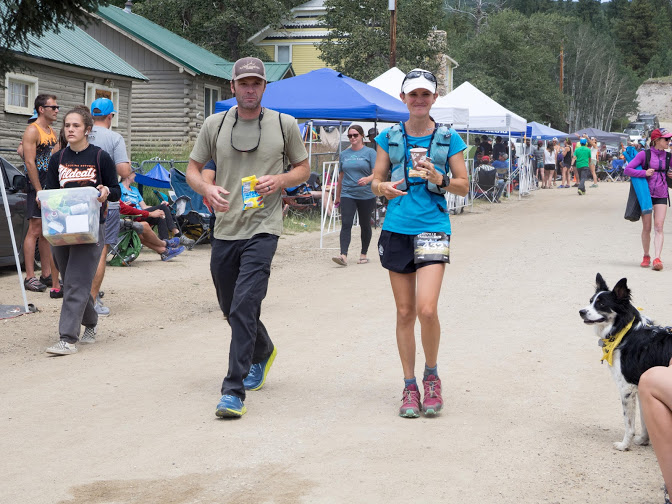

I rolled into Twin Lakes and somehow my husband found me right away. I walked through the food/drink stations and onto our CAF tent where the rest of the crew was parked.
I’m telling you, this place was bigger than the expo the day before. There were tons of people. It was amazing.

I walked up and immediately saw my 2 year old son and started to cry. I’m not sure why or how to explain the overwhelm of emotion. It must be a mix of exhaustion and love? I was just so damn happy to see them.
Once I got to the tent, my crew sat me down (there goes my goal of no sitting at aid stations), because I had a toe to deal with. They helped me take my shoes off and my husband wrapped my blistered toe with tape. It was basically on the verge of popping but never did. Guess the hubs knew what he was doing.
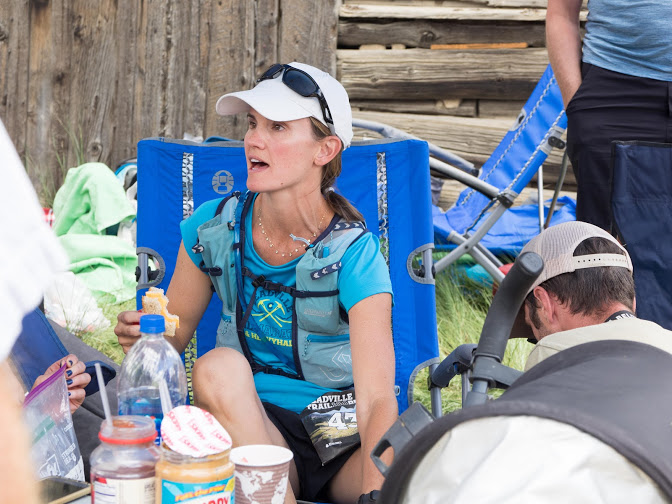
Twin Lakes is right before Hope Pass, so this is the time to get ready for the biggest and hardest climb of the day. My crew covered me in sunscreen and bug spray and I had some snacks while parked there too. Once I refueled and grabbed my poles, I was on my way.
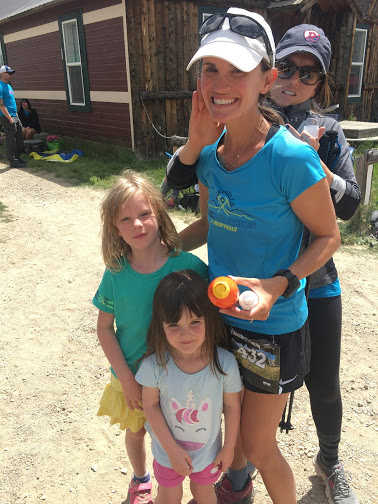
So, I chose to grab my poles at Twin Lakes and just keep them with me the rest of the race. My teammates grabbed theirs earlier on in the race. I think it’s just personal preference on whether or not you love running with your poles.
When you leave Twin Lakes, you start out running through some grassy spots into more of a marsh area. Now it’s time to get wet.
The days before the race, my team and I headed out here to check out the water situation. Honestly, it made me nervous. I was afraid my feet would get wet and my shoes would rub on them creating hot spots and blisters. My initial thinking was, maybe I could take my shoes off and walk through the water, then put my dry shoes back on. Well, that would have been a complete waste of time. Once we saw the water, we knew that was out of the question.
We crossed 6 or 7 (or maybe more?) marshes. The water was warm in some spots, then freezing in others. Once we got through those spots, we crossed running water: Lake Creek. There is a cable running through the water so runners can hold onto that while crossing. It really isn’t too far and it wasn’t terribly deep. The water went up to my knees and I’m 5’5″. However, the water was freezing. My feet were radiating pain coming out of that water just because of the temperature. But the discomfort didn’t last. Before I knew it, I forgot my feet were even wet. It was never a problem.

After the creek crossing is when the climbing starts. I have to say, my experience on this side of Hope was pretty good. I started chatting with another runner and managed to find a pace that worked for me. I felt like I fell into a nice rhythm with my pace and my breath. One thing that worked for me was breathing through my nose. Now, don’t get me wrong, I wasn’t quietly, delicately breathing through my nose like I was sleeping. It was a working breath, but I never pushed hard enough to where I had to breath through my mouth.
I really feel like that breathing helped me. I constantly hydrated (it was warm and sunny), and kept up on my snacks too.
What can I say about this climb? You will literally be climbing for 3400 feet until you hit the mini Hope Pass aid station which is about a 1/2 mile from the top.
At this aid station, I got my phone out for the first time, snapped pictures of the llamas, grabbed some food, and kept climbing.
I got to the Hope Pass aid station at 11:07, but wanted to get there at 10:14.
My biggest piece of advice for this section of the race is find a rhythm! Find a nice rhythm between your breath and your pace and just keep at it. Do not forget to stay hydrated and eat some food. This section is very difficult and you cannot do it without proper nutrition.
Hope Pass to Winfield-6.5 miles
To the top of Hope!! Praise the Lord I was there. I got my phone back out, took a selfie, checked out the view of Twin Lakes, and started down.
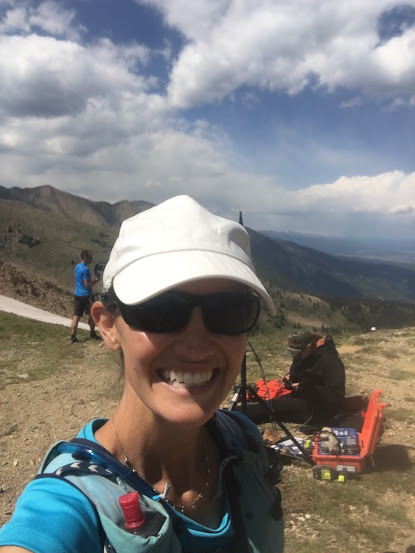
This top portion going down to Winfield was really tough for me. It’s basically a single track trail of steep switch backs. My knees at this point were feeling wrecked. Putting one foot down, then another, was taking me so much time I didn’t know if I’d make it all the way down. I was hoping it would be an opportunity to make up some time since it was all downhill, but my knees were not having it.
I did end up taking a couple Tylenol and suppose that’s what helped me. Or maybe it was my bestie David Goggins. I saw him as he was coming back up to Hope. That was definitely an awesome moment. Eventually, I got to a point where I felt like I could go a little faster.
The knee pain was sort of interesting from there on out because it would almost come and go. For periods of time it was unbearable, then it would (almost) subside. I’m not sure why or how that happened, but I’m thankful it did.
This side of Hope is all down hill until the last few miles. Once you hit a flatter spot and you’re almost to Winfield, there’s a stretch of dirt trail that feels like it goes on forever. I’ve actually done it before, so I knew when it ended, yet it still felt like it would never end. The trail eventually puts you on a dirt road that winds around and drops you into Winfield. Winfield is the 50 miles mark and where you can pickup your first pacer. Man I was glad to see her.
I got to Winfield at 13 hours and 8 minutes and wanted to get there at 12:08. Exactly one hour off. That was a little after 5 o’clock and the cutoff time was 6pm.
My biggest piece of advice for this portion of the race is if you’re feeling good, by all means, run where you can. If you’re like me and your knees feel like they’re broken, go slow and use your poles to catch your body weight coming down. Try to remind yourself that pain is temporary. Because it is (usually). In this case, the pain will come back, but you’ll probably have moments when it isn’t so bad and you can pickup the pace again.
Winfield to Hope Pass Inbound- 6.5 miles
Holy shit I ran 50 miles! Okay, that alone was incredible. But now, we gotta head home.
I picked up my pacer, Becca, at Winfield and it was just so great having someone with me. I also snagged some broth and potato chips at the aid station so once we left, we walked for a bit so I could eat. Then it was time to climb!

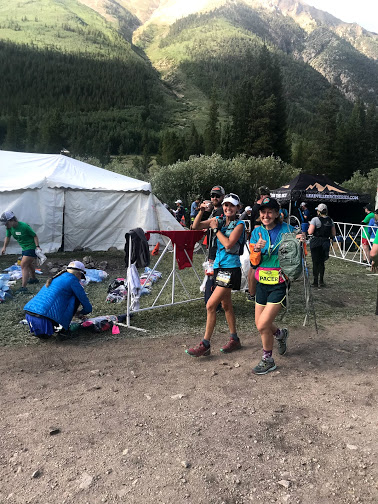
This side of Hope starts with a pretty steep stretch of climbing. I practiced this a couple times before the race, but obviously on race day it felt much harder and much longer. Once we got through the really steep stuff though, there were more stretches of climbing mixed with flat spots. The ground throughout this portion is also relatively soft. Until you get to the rocks.
There is a spot on this side of Hope that is literally covered in boulders. It’s pretty short, but you just need to be careful where you step and where you place your poles.
After the rocks, we were back at the switchbacks on our way to the top of Hope. Since people picked up pacers in Winfield, there were a couple of times the trail bottle-necked with people. My pacer did a great job being vocal about us passing other runners. I had some stretches in there when my energy was high and I was fully capable of going faster and passing, so I’m glad my pacer helped move me along.
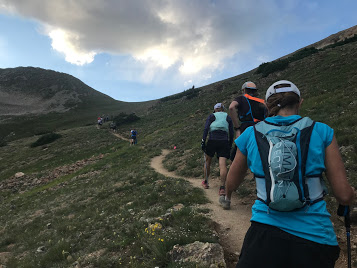

Passing other runners is funny because back at the start of the race, I was more uncomfortable passing. But now on Hope Pass, we were passing people left and right. The bottom line is: no one cares if you want to pass them. Pass away. I passed runners and plenty passed me too.
At the top of Hope, the wind had picked up so I put my jacket back on for the first time. I had my jacket with me the entire race and I’m glad I did.
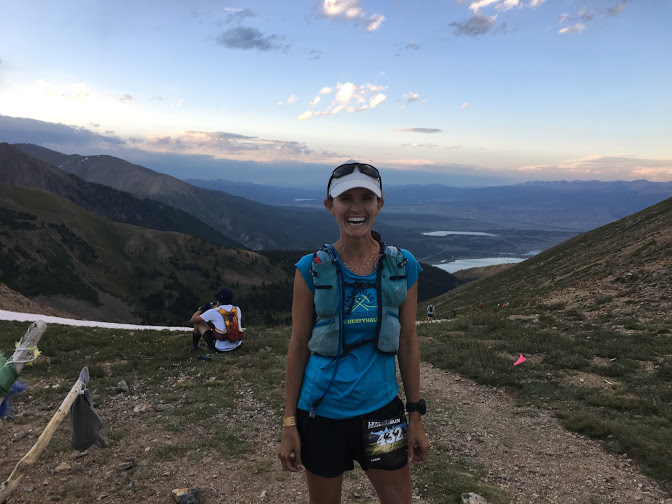
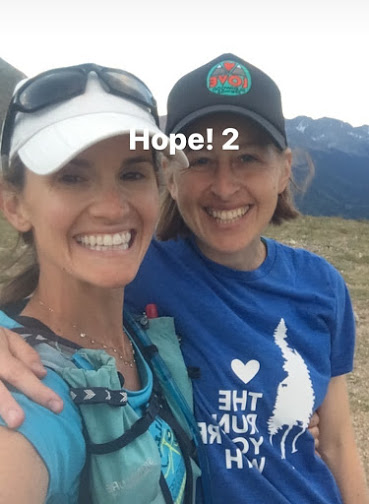
We made it back to the Hope Pass aid station at 15 hours and 33 minutes. My goal was to be there at 15 hours and 15 minutes so we made up a lot of time.
My biggest piece of advice for this portion is to communicate with your pacer. Tell them what you need, tell them what you want to eat, have them carry your pack, tell them to remind you to drink water every 15 minutes, whatever it is. That’s what they’re there for. This was my first race using pacers, so it was a learning experience for me too. They are definitely crucial to finishing.
Hope Pass to Twin Lakes-5.6 miles
Now we are starting to get into night time. Coming off of Hope Pass, the weather stayed nice but started to get a little chilly. My knees started bothering me again too.
The downhill on this side of Hope, in my opinion, is not as bad as the Winfield side. The real issue we ran into was the fact that I did not have a headlamp with me. Looking back, I have no idea what I was thinking (I clearly wasn’t). I bought an emergency headlamp but put it in my drop bag to be picked up at the next aid station (Twin Lakes) along with my other headlamp. So 2 headlamps, 1 aid station. Obviously the e-lamp would have made a lot more sense in my pack. Ya know, in case of emergencies.
Luckily my pacer had a headlamp so we weren’t completely in the dark. She wore it for a while, then I wore it. It just got so dark that even 1 headlamp felt a little unsafe in spots.

We made it back to the water and it felt even colder than before (probably because it was). And finally, rolled back into Twin Lakes.
My goal time to be back at Twin Lakes was 17 hours and 6 minutes. I’m actually unsure what time I got there because this Twin Lakes check in was never posted.
My biggest piece of advice for this part would be to have a headlamp with you!
Twin Lakes to Half Pipe Inbound- 8.6 miles
We rolled into Twin Lakes and I was back in the chair. This time, I changed my shoes and socks (they were wet), and put on all my colder weather gear. I had some broth (broth and potato chips were my jam), grabbed my husband, and headed out with about 15 minutes to spare before cutoff.
We left Twin Lakes and started uphill on a dirt trail. I feel like I could have done a better job during this part of the race. I stopped multiple times for a slew of reasons ranging from being hot, to being cold, to having to pee, etc. Just too many stops. Not being efficient with my time.
My energy level and mindset were still doing pretty good. I hadn’t really entered a dark place yet. I still had some serious pain on and off, but overall, I felt pretty darn good.
My piece of advice for this part would be to get going. This race is about to get much harder. This is a good place to get in some time if you’re feeling decent.
My goal was to be at Half Pipe at 19 hours 9 minutes and I got there at 20 hours and 44 minutes. That’s 12:44 am and the cutoff time was 1:15.
Half Pipe to Outward Bound– 5.8 miles
Things started to get a little dark during this portion of the run and they were only going to get darker. As I got closer to Outward Bound, I started feeling more and more defeated.
My first issue was I got incredibly cold. I have to shout out to my husband and all the gear he had with him. If it wasn’t for him and his (literally) 6 jackets that I wore, I’m not sure I would have made it.
Once we made it out of the mountains and were back on that road towards Outward Bound, I started to freeze. I was wearing my shirt, a long sleeved base layer, a heavier Patagonia jacket, my husband’s puffy jacket, a Salomon softshell jacket, a Heli Hanson jacket, pants, gloves, and a headband. Honestly, how the hell I was cold I have no idea. I’m just thankful I have a husband who was willing to give me all his clothes.
Once we started through the grass before the aid station, I was at my lowest mentally. I felt a little lost (the path was lit by some small glow sticks), tired, and just over it. My husband pushed me through though and we finally made it to Outward Bound to pickup my next pacer.
We got to Outward Bound at 22 hours and 39 minutes and my goal time was 21 hours and 3 minutes. That’s about 2:40 in the morning and the cutoff time was 3am.
My biggest piece of advice for this section is bring a lot of warm clothes! Have your pacer bring clothes too. My husband initially thought he had way too much stuff, but I used all of it.
Outward Bound to May Queen- 10.9 miles

Oh man you guys. This section was one of the worst. Remember back when I mentioned Powerline? Well, turns out when you go down one side, then turn around, you have to go up. Keep in mind this was about 2-3 in the morning too.
I picked up my pacer, Matt, and we started up the street back towards the mountains. I felt a little rejuvenated picking up a fresh face for some reason. One thing I will say about this part was it was NOT well lit or well marked. We did not see any other headlamps for a decent amount of time and we were actually a little concerned that we were going the wrong way. At one point, I started walking into the woods-completely wrong direction (that may have been a mix of exhaustion and trail uncertainty). The trail was marked by small glow sticks, but they were so small and spread apart. Eventually, we did catch some other headlamps though so we knew we were on the right path.
Then the climbs began. What people say about the “false summits” is absolutely true. I swear it felt like there were a minimum of 7 false summits, before we actually hit the summit. The false summits coupled with zero sleep and 70 whatever miles behind me were grueling. I think I can speak for both of us when I say we were pretty damn happy when it started to move downhill. At least for a brief moment.
My body was really starting to kill me at this point, especially my left leg. It’s difficult to pinpoint an exact location of pain because the whole leg was in pain. Downhill was nice for about 2 minutes, then it became excruciating. Matt did a great job keeping me on a pace that would get me to May Queen before the cut off, but it was not easy.
The pace he had me at would get me there before cutoff, but super close to the cutoff time. Scary close. It scared me enough that I forced myself to go into a run. My legs hurt so bad that my run turned into more of a skip to try and keep off my left knee.
At one point before the aid station we could hear the people. We were almost there! But, we weren’t yet. Somehow we could hear the people, but couldn’t see them yet. This sort of a tease was like torture for me. That last leg before we saw them felt like it lasted forever. It was downhill and rocky, not a good combination for someone whose legs feel shattered.
Finally, we got onto a dirt road and continued our run/skip until we got to the aid station. We had 5 minutes to spare before the cutoff. It was the first time in this race where I was actually unsure if I’d finish. How devastating would that be? Get to 87 miles and get cut off. But we made it. I cannot begin to explain the feelings I felt before getting to May Queen. It was incredibly overwhelming emotionally and physically.
We got to May Queen at 26 hours and 25 minutes. My goal was to be there at 24 hours 36 minutes. Got there at 6:25 and the cutoff was 6:30. It was incredible.
My biggest piece of advice for this portion is you’re going to encounter false summits. It’s brutal in the middle of the night, but just know that going in. Also, if you can run at all, run. I lost time earlier on when I should have ran but I didn’t, so we cut it close.

May Queen to Finish- 13.5 miles
I ran into May Queen and started crying when I saw my pacer, Kim. The emotional and physical overwhelm was catching up to me. I was so close to being cut off, but now it was time to finish.
The cut off times at aid stations mean you have to be there and then gone before that given cut off time. So, I didn’t have any time to spare at May Queen. We grabbed some broth and gels, and hit the road. I had to pee but there was just no time.
Kim and I headed back into the woods on that single track trail I ran on the day before at sunlight. She was the perfect pacer for this part of my race. I was in a bad place. I couldn’t think straight and was exhausted. Kim did all the thinking for me. She knew exactly what pace I needed to get there before cut off. She would basically set mini goals for me. We would run for a certain amount of time, then stop and walk for a certain amount. She also kept tabs on my eating and drinking and kept handing me Gu gels, cookies, and cheese bunnies about every 15 minutes.
This stretch to the finish line felt like it would never end (which seems to be an ongoing theme in this race). We ran around the lake and eventually got to a dirt road. I was getting pretty hot by then so I shed some layers.
We kept up the same strategy of running/walking basically all the way to the finish. Eventually on this dirt road, I ran into my husband which was so awesome for me. Seeing him gave me a little burst of energy. Cliff and Kim gave me the support I needed during these last few miles.
Even though the race was almost over, there were some decent hills in this section. We were facing the sun so the heat made the climbs that much harder. I was told at one point we were about to hit a downhill, but nope, just more uphill.
I kept wondering when the dirt road would turn into the paved road. Felt like forever, but eventually it did. Seeing that paved road meant the race was almost over. I was so ready to get there. My body was broken but I managed to pickup my pace because, let’s be honest, I wanted this shit to be over.
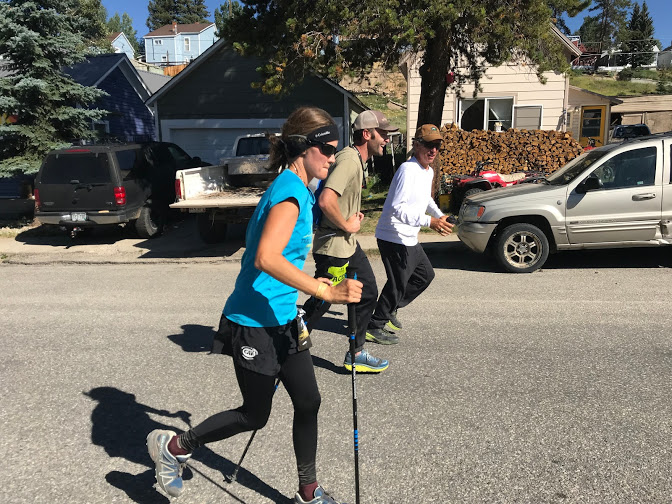
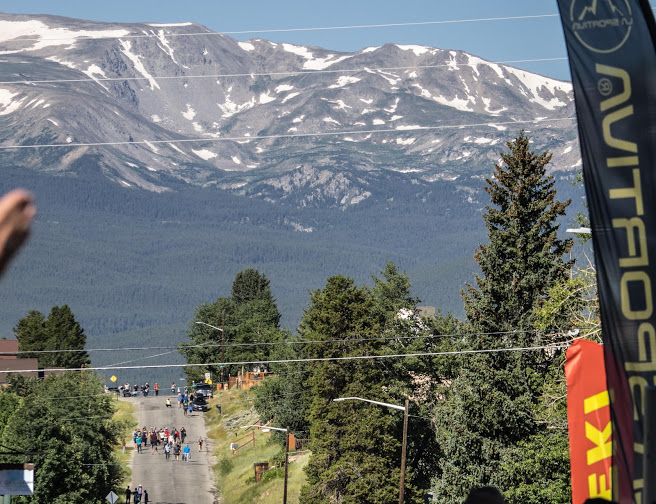
Eventually, we turned on the paved road and the finally saw the finish line. It was over and I could not believe it. I ran. I ran my ass to the finish line. Honestly, probably the fastest pace I ran during the entire race. I finished with 8 minutes until the cutoff.
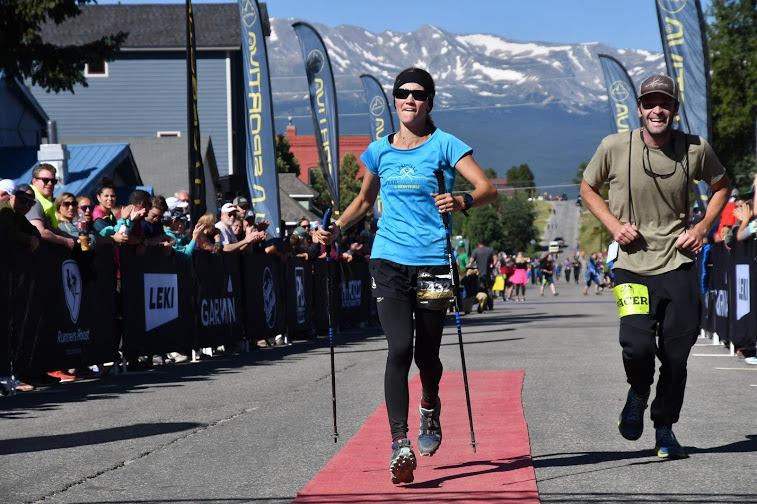
The race ended at 10am, and I came through the finish line at 9:52. My average pace overall was 17:51.

My biggest piece of advice for this section is to keep moving!! Tell your pacer to do the thinking for you. Ask them to keep you on pace, keep tabs on food, carry your pack. Anything and everything to get you over the finish line.
Afterthoughts:
I’ll start out by saying this was an incredible experience. On the one hand, I always felt fairly confident that I could finish, but on the other hand, I’ve never even come close to this distance…so what did I know? The longest I’ve ever ran was 30 miles, so all the unknowns about this distance, terrain, and elevation made me nervous.
I’m not a super athlete or anyone particularly special. I say that because this experience is an example of pushing yourself and your limits to see just how far you can go. Turns out, I can go farther than I ever thought possible. And if I can do it, you can too. It doesn’t have to be 100 miles, it could be whatever you think is “impossible” for yourself. It’s sort of cliche, but it’s true. If you never try, you never know. We tell that to our children all the time because we know it’s true, yet we don’t apply it to our own lives.
As Ken Chlouber, the founder of the Leadville race says, “You’re better than you think you are. You can do more than you think you can.” I couldn’t agree more.

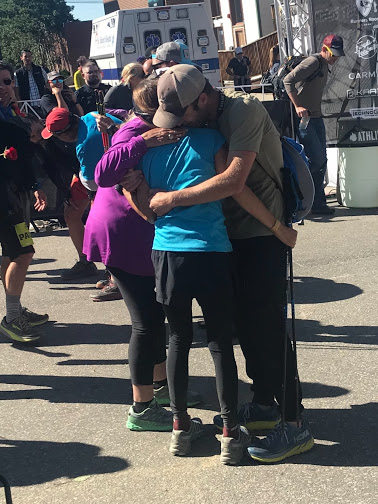
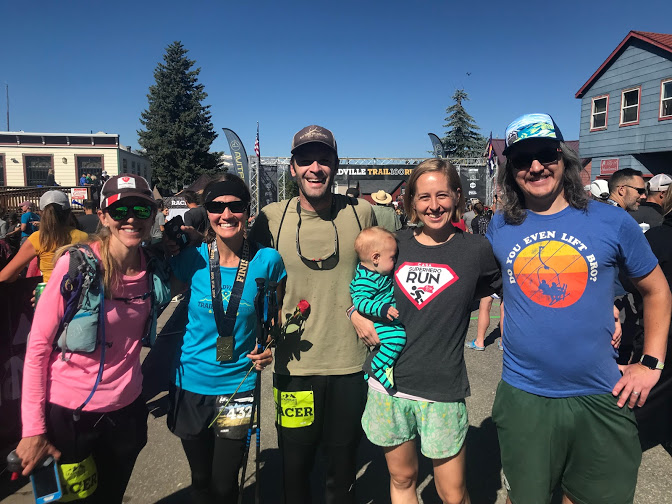
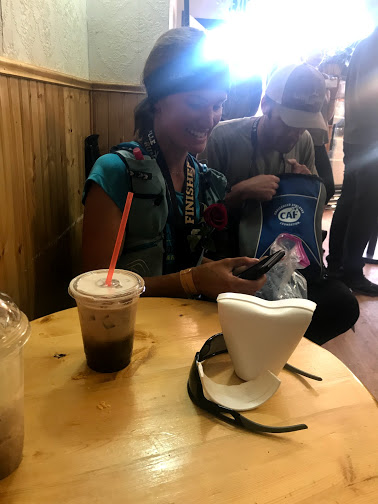
Just visited leadville! I can’t imagine running at that elevation. Congrats on the accomplishment.
Thank you! Leadville is a pretty cool place!